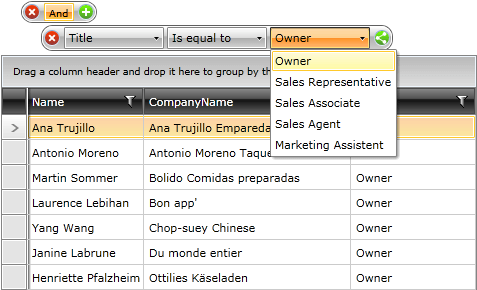Create Custom Filter Editors
You can find the complete source code used in this article in the Custom Filter Editors example of the Telerik WPF Demos application. .
If you want to specify a custom filter editor you can do it by using the EditorTemplateSelector property of the control. Once the editor (custom or default) is created, you can add the final touch to it by attaching to the EditorCreated event.
Note that this approach can be used to create a custom editor of any kind!
This topic will show you how to use a RadComboBox as a filter editor. For this purpose you have to create two classes:
EditorTemplateRule - this class is used to associate a particular DataTemplate with a filtering member.
EditorTemplateSelector - this class will represent the actual template selector. It should inherit the DataTemplateSelector class and override its SelectTemplate() method. It also should contain a collection of EditorTemplateRule objects. In the override for the SelectTemplate() method you should iterate the collection of EditorTemplateRule objects and return the DataTemplate appropriate for the currently created editor.
At the end of the topic you can find the code for the Employee business object used in this example and some sample data of this type.
In XAML you have to create an instance of the selector, define its rules collection and set it to RadDataFilter. Also you have to attach an event handler for RadDataFilter's EditorCreated event. In it you can add your final touches to the editor. In this example this will be represented by populating RadComboBox with items. If you take a look at the defined rule, you can see that the Title property has been associated with the ComboBoxEditor template. This means that whenever the Title is selected as a filtering member RadComboBox editor will appear.
In order to make the filtering possible, you have to bind the value property of the control that you are using to the Value property of the DataTemplate's DataContext by using a TwoWay binding mode. In this case this is the SelectedValue property.
In order to set the case sensitivity, you have to bind the IsCaseSensitive property of the DateTemplate’s DataContext, also using a two-way binding.
<UserControl.Resources>
<DataTemplate x:Key="ComboBoxEditor">
<telerik:RadComboBox SelectedValue="{Binding Value, Mode=TwoWay}"
MinWidth="100" />
</DataTemplate>
<local:EditorTemplateSelector x:Key="EditorTemplateSelector">
<local:EditorTemplateSelector.EditorTemplateRules>
<local:EditorTemplateRule PropertyName="Title"
DataTemplate="{StaticResource ComboBoxEditor}" />
</local:EditorTemplateSelector.EditorTemplateRules>
</local:EditorTemplateSelector>
</UserControl.Resources>
<Grid x:Name="LayoutRoot"
Background="White">
<Grid.RowDefinitions>
<RowDefinition Height="Auto" />
<RowDefinition />
</Grid.RowDefinitions>
<telerik:RadDataFilter x:Name="radDataFilter"
EditorTemplateSelector="{StaticResource EditorTemplateSelector}"
EditorCreated="radDataFilter_EditorCreated" />
<telerik:RadGridView x:Name="radGridView"
ItemsSource="{Binding FilteredSource, ElementName=radDataFilter}"
AutoGenerateColumns="False"
Grid.Row="1">
<telerik:RadGridView.Columns>
<telerik:GridViewDataColumn DataMemberBinding="{Binding Name}" />
<telerik:GridViewDataColumn DataMemberBinding="{Binding CompanyName}" />
<telerik:GridViewDataColumn DataMemberBinding="{Binding Title}" />
</telerik:RadGridView.Columns>
</telerik:RadGridView>
</Grid>
Here is the code behind of the example. The most important thing in it is the event handler for the EditorCreated event. In it you can fill RadComboBox editor with the desired data.
As you can see by using the switch statement you can extend the logic for additional custom editors by adding more cases.
public partial class CustomFilterEditorsSample : UserControl
{
public CustomFilterEditorsSample()
{
InitializeComponent();
this.radDataFilter.Source = SampleData.GetEmployees();
}
private void radDataFilter_EditorCreated( object sender, EditorCreatedEventArgs e )
{
switch ( e.ItemPropertyDefinition.PropertyName )
{
case "Title":
( ( RadComboBox )e.Editor ).ItemsSource = this.GetTitles();
break;
}
}
public List<string> GetTitles()
{
return new List<string>() { "Owner", "Sales Representative", "Sales Associate", "Sales Agent", "Marketing Assistent" };
}
}
Public Partial Class CustomFilterEditorsSample
Inherits UserControl
Public Sub New()
InitializeComponent()
Me.radDataFilter.Source = SampleData.GetEmployees()
End Sub
Private Sub radDataFilter_EditorCreated(sender As Object, e As EditorCreatedEventArgs)
Select Case e.ItemPropertyDefinition.PropertyName
Case "Title"
DirectCast(e.Editor, RadComboBox).ItemsSource = Me.GetTitles()
Exit Select
End Select
End Sub
Public Function GetTitles() As List(Of String)
Return New List(Of String)() With { _
"Owner", _
"Sales Representative", _
"Sales Associate", _
"Sales Agent", _
"Marketing Assistent" _
}
End Function
End Class
Here is a snapshot of the final result:

Here is the code for the Employee object and the sample data.
public class Employee
{
public Employee( string name, string companyName, string title )
{
this.Name = name;
this.CompanyName = companyName;
this.Title = title;
}
public string Name
{
get;
set;
}
public string CompanyName
{
get;
set;
}
public string Title
{
get;
set;
}
}
Public Class Employee
Public Sub New(name As String, companyName As String, title As String)
Me.Name = name
Me.CompanyName = companyName
Me.Title = title
End Sub
Public Property Name() As String
Get
Return m_Name
End Get
Set
m_Name = Value
End Set
End Property
Private m_Name As String
Public Property CompanyName() As String
Get
Return m_CompanyName
End Get
Set
m_CompanyName = Value
End Set
End Property
Private m_CompanyName As String
Public Property Title() As String
Get
Return m_Title
End Get
Set
m_Title = Value
End Set
End Property
Private m_Title As String
End Class
ObservableCollection<Employee> employees = new ObservableCollection<Employee>();
employees.Add( new Employee( "Maria Anders", "Alfreds Futterkiste", "Sales Representative" ) );
employees.Add( new Employee( "Ana Trujillo", "Ana Trujillo Emparedados y helados", "Owner" ) );
employees.Add( new Employee( "Antonio Moreno", "Antonio Moreno Taqueria", "Owner" ) );
employees.Add( new Employee( "Thomas Hardy", "Around the Horn", "Sales Representative" ) );
employees.Add( new Employee( "Hanna Moos", "Blauer See Delikatessen", "Sales Representative" ) );
employees.Add( new Employee( "Frederique Citeaux", "Blondesddsl pere et fils", "Marketing Manager" ) );
employees.Add( new Employee( "Martin Sommer", "Bolido Comidas preparadas", "Owner" ) );
employees.Add( new Employee( "Laurence Lebihan", "Bon app'", "Owner" ) );
employees.Add( new Employee( "Elizabeth Lincoln", "Bottom-Dollar Markets", "Accounting manager" ) );
employees.Add( new Employee( "Victoria Ashworth", "B's Beverages", "Sales representative" ) );
Dim employees As New ObservableCollection(Of Employee)()
employees.Add(New Employee("Maria Anders", "Alfreds Futterkiste", "Sales Representative"))
employees.Add(New Employee("Ana Trujillo", "Ana Trujillo Emparedados y helados", "Owner"))
employees.Add(New Employee("Antonio Moreno", "Antonio Moreno Taqueria", "Owner"))
employees.Add(New Employee("Thomas Hardy", "Around the Horn", "Sales Representative"))
employees.Add(New Employee("Hanna Moos", "Blauer See Delikatessen", "Sales Representative"))
employees.Add(New Employee("Frederique Citeaux", "Blondesddsl pere et fils", "Marketing Manager"))
employees.Add(New Employee("Martin Sommer", "Bolido Comidas preparadas", "Owner"))
employees.Add(New Employee("Laurence Lebihan", "Bon app'", "Owner"))
employees.Add(New Employee("Elizabeth Lincoln", "Bottom-Dollar Markets", "Accounting manager"))
employees.Add(New Employee("Victoria Ashworth", "B's Beverages", "Sales representative"))